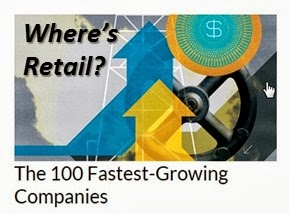Fortune magazine recently published the 100 fastest growing companies. (1) Analyzing this year's list:
- Revenues for the top 100 global fastest growing companies totaled over $627 Billion, up from $390 Billion a year ago. Apple, which was part of this group, had revenues of $169 Billion and profits of $39.7 Billion.
- The industry sectors that have outperformed the rest over the last 15 years include technology, health care, energy, and industrials.
What happened to retail? A very interesting graph published by Fortune in this month's issue has retail consistently near the bottom in terms of high growth over the past 15 year business cycles. (2) For 2013, retail ranked 5th. As an overall share contribution over the last 15 years, retail averaged 7%, second to the last sector of mining which averaged 2%.
The following are the only seven retail companies that made the 2013 list of 100 fastest growing companies: Lithia Motors (Number 14 on the list); Lululemon (No.21); Rush Enterprises (No.27); Liquidity Services (No.48); Ulta Cosmetics (No.58); Steven Madden (No.77); and 51job (No.79).
The clues as to why retail has consistently lagged other industry sectors have been discussed in this blog on multiple occasions.
- The retail industry has consistently under invested in technology as a differentiator to evolve their business model. As discussed in the blog "The Evolution of Retail on a Shoe String Budget" http://ow.ly/pig7N, the retail industry averages around 1% IT spend as a percent of total sales. This percentage contrasts to all other industry sectors which according to the latest CIO survey averaged over 5% IT spend.
- Investments in customer interaction technologies have lagged other industry sectors.
- Few retailers have taken a holistic view of the store. Investments have been isolated to applications typically at the peripheral of the sales floor. From a consumer point of view, the inside of the store which is where the customer makes the buying decision has remained static and unconnected for decades.
A clue on the challenges that retail faces in contributing more revenue to the 100 fastest growing companies was also published in this month's Fortune. "Almost a decade after Mark Zuckerberg started the Facebook in his Harvard dorm, virtually all major businesses (and plenty of small companies) are using social tools to sell goods and services, hire and manage employees, and handle customer complaints. Marketing executives polled in February by the CMO Survey say they expect in five years to spend, on average, 21.6% of their marketing budgets on social media outlets, up from an average of 8.4% today. Fortune surveyed the business community and talked to the leading digital platforms to find best-in-class users of social media." (3) Not one of the five social media all-stars identified by Fortune is from retail.
Why is retail not a high growth industry? The in-store shopping models are static while concurrently a tech savvy consumer is looking for much deeper engagement in building their own personal positive customer experience. Shopping is a contact sport. Lacking interactivity with the store itself, consumers are turning to technology to make purchasing decisions. An interactive store needs to converge with the tech savvy consumer for more global retailers to step up to the 100 fastest growing list of companies.
(1) http://ow.ly/piTC2 (2) http://ow.ly/piUrj (3) http://ow.ly/piWYA Image from http://ow.ly/piYdO
















